The advantage of working long days is that we get to see the forest wake up. This morning near Lac La Biche is dewy, creating a glistening carpet!
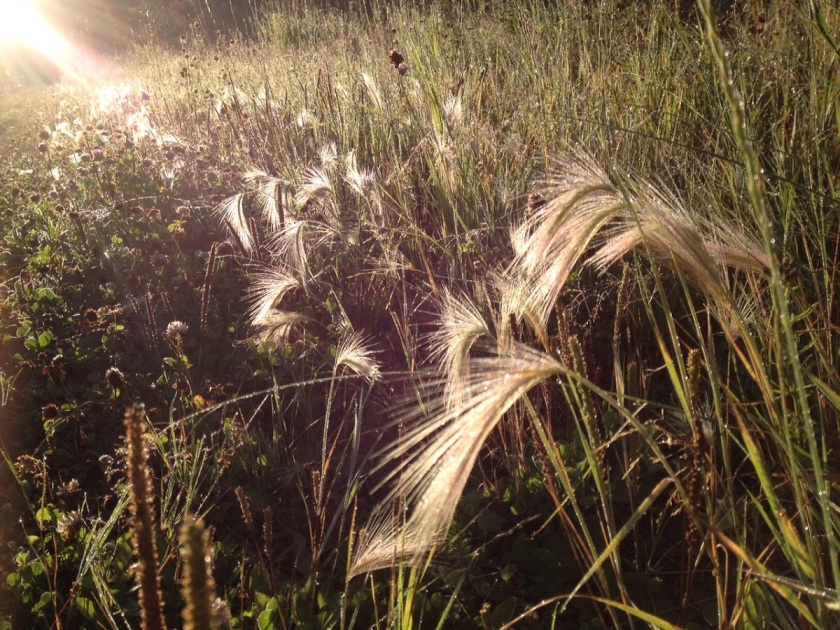
The advantage of working long days is that we get to see the forest wake up. This morning near Lac La Biche is dewy, creating a glistening carpet!

At our Archaeology Roadshow event in Lac La Biche, in fall 2015 Allan and Juanita Gaudreault brought in several conch shell fossils. These shell fossils were heavily worn and most were down to the central spiral. This made them difficult to identify at first. These are very unusual specimens because these type of marine shells are not found in Alberta. They are native to the Gulf of Mexico. Our initial interpretation (as archaeologists, not palaeontologists) was that this could possibly be a discarded souvenir or a fossil from the Cretaceous period when an ancient seaway stretched from the Arctic to the Gulf of Mexico.
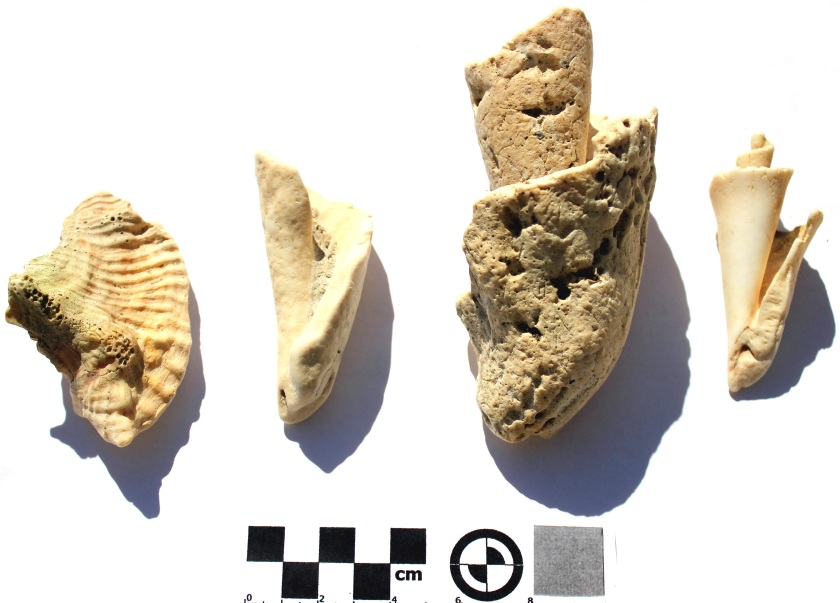
Tree Time Services reached out to Alwynne Beaudoin, Curator of Earth Sciences and Quaternary Environments at the Royal Alberta Museum (RAM), for an answer. The RAM had a conch shell, also found in the Lac La Biche region, donated to the museum in 2011. She has been researching this conch shell and “has not been able to find another record of a conch in prehistoric context from Alberta, though there are records of other marine shells (and) they are unlikely to be Cretaceous.”
Furthermore, the specimen in the Royal Alberta collection was radiocarbon dated to “slightly more than 1000 years before present.” That specimen’s age debunks the discarded tourist souvenir theory. The most likely explanation for the RAM’s shell is prehistoric trade from the Caribbean to Alberta 1000 years ago. There are some artifacts found in Southwestern Manitoba, such as this shell gorget, made from a species of shellfish native to the Gulf of Mexico. However, evidence of prehistoric trade networks between the Canadian Plains and the Gulf of Mexico is extremely rare in Alberta and this would be an artifact of significant information potential.
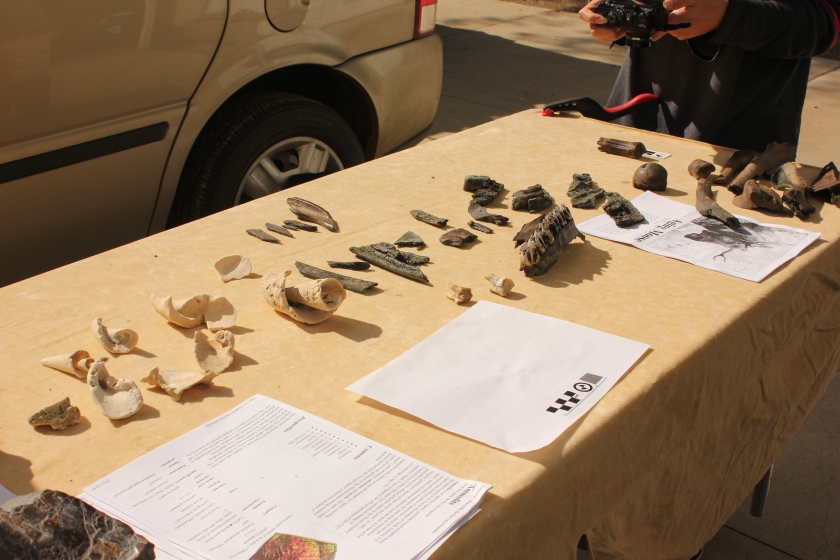
The potential that the 2015 shells represented trade or travel 1000 years ago, rather than palaeontology from millions of years ago, was pretty exciting. On September 7, 2016 Corey Cookson, Project Archaeologist at Tree Time Services, and Christina Barron-Ortiz, Assistant Curator at the Royal Alberta Museum, made the trip up to the Gaudreault’s home to view the rest of their collection. Upon another viewing of the conch fossils it was clear that our first interpretation was right, and these are remains from the Cretaceous period about 65 million years ago. With permission from the Gaudreaults, a representative sample of the shells were taken by Christina Barron-Ortiz for further study. We will post a future blog once we receive confirmation of the age of the shell fossils. Also stay tuned for another post about some other interesting fossils from the Gaudreault collection.
At our Archaeological Roadshow event in Lac La Biche, AB Allan and Juanita Gaudreault brought in a collection of fossils. The fossils were fragments of a darkly stained bison jaw and a set of blueish grey horse teeth. Mr. Gaudreault told us the specimens were found in a low area near a lake. We came up with two possible interpretations of these specimens: they may have been permineralized due to being in a place with very hard groundwater; or could be dated to the early Holocene.
It is quite rare to find animal remains in the boreal forest in central and northern Alberta. The acidic soils of the boreal forest make for very poor preservation conditions. Animal bone is therefore rare, and these finds could help teach us about past environments in the region.
Tree Time Services reached out to Chris Jass, Curator of Quaternary Palaeontology at the Royal Alberta Museum (RAM), for more information on determining a possible age for the specimens. Jass confirms that “you can get fairly dark staining and mineralization fairly quickly depending on the depositional environment. However, if there’s a horse there, (the Gaudreaults) may be finding some older material.” Horses were native to North America, but went extinct sometime between 13,000 and 11,000 years ago (North American horse teeth were also recently found at the Brazeau Archaeological Survey project ). The horses that are ubiquitous in North America today were introduced by the Spanish in the late 15th and early 16th centuries. Due to the fossilized nature of the specimen and the recovery of the teeth from a possible relic lake bed, these horse teeth may be from the extinct North American horse.
Chris Jass goes on to state that he has “been working with a diver who has been pulling bones out of Cold Lake, and we’ve got Pleistocene dates (>11,700 years ago) on a bison that he’s recovered from the lake. I think there is considerable potential for recovery of late Pleistocene/early Holocene (ca. 11,700 years ago) material in many of the lakes in Alberta.”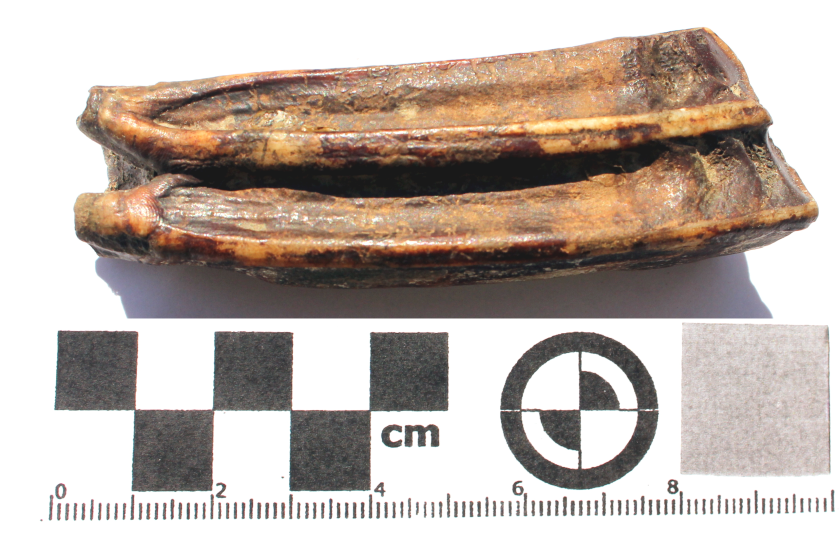
On September 7, 2016 Corey Cookson, Project Archaeologist at Tree Time Services, and Christina Barron-Ortiz, Assistant Curator at the Royal Alberta Museum, made the trip up to the Gaudreault’s home to view the rest of their collection. Christina Barron-Ortiz is a specialist in horse and bison teeth. She confirmed that the horse tooth has the characteristics of several specimens the Royal Alberta Museum recovered from the lake bed near Cold Lake, AB. She also suspected that the bison jaw bone represented ancient bison but could not be as sure as the horse. With permission from the Gaudreaults, the bison jaw and horse tooth were collected and results from carbon dating are expected in the Spring.
At our Archaeology Roadshow in Lac La Biche, AB in fall 2015 a local resident brought in an interesting artifact that was found on a farm near Camrose, AB in the 1940s. The artifact is a 5 and 1/2” round stone with a wide, shallow depression on one side and a smaller lipped depression on the other side. These depressions were formed by grinding or pecking at the stone with a harder stone.
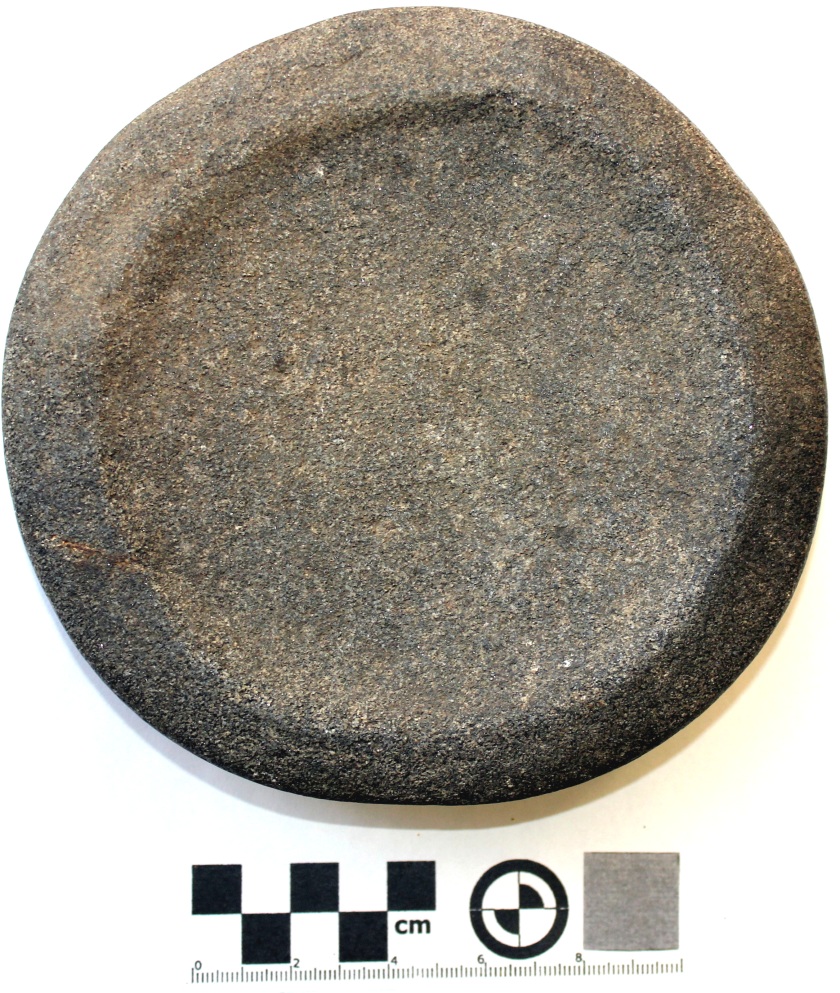
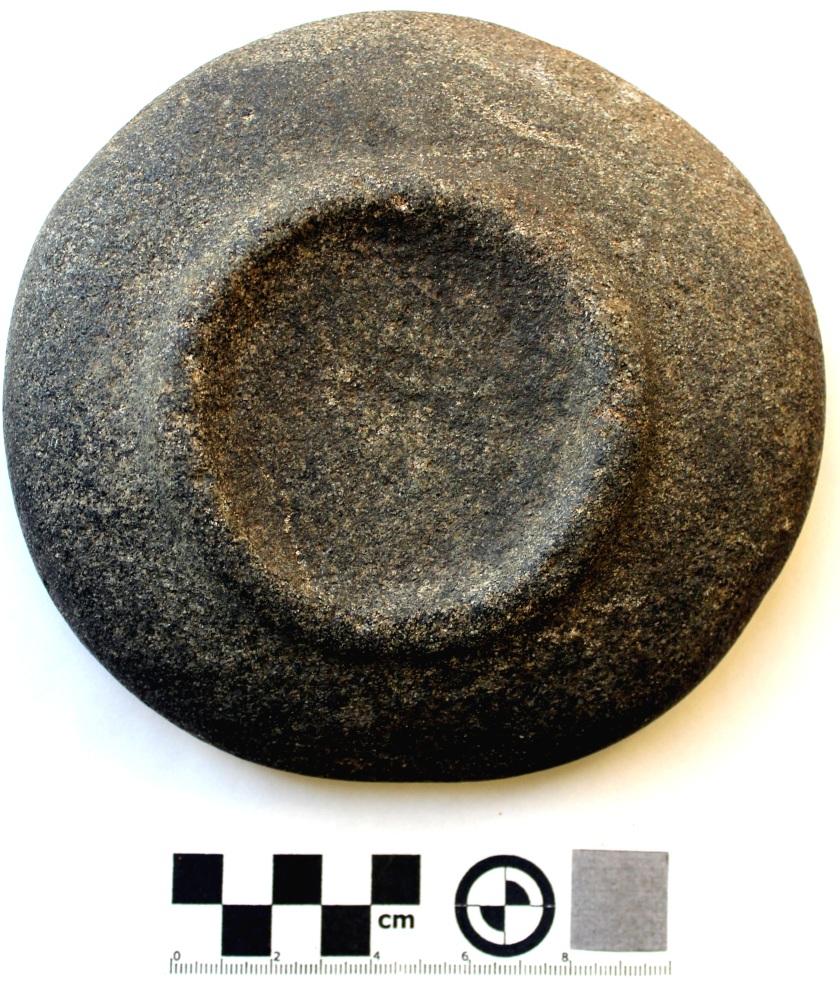
Initial interpretation of the artifact was that it was some sort of bowl or plate. However, there are some problems with this interpretation. First, it would not function well as a bowl due to the shallow depth on the “top” side of the artifact. Second, it also requires a lot of effort to grind these concave features into the stone for something as simple as a serving vessel. Traditionally it was thought that a vessel of this type would not serve much purpose to Native person prior to the arrival of Europeans. Before European contact, people were mobile hunters and it would not make sense to create a plate to be transported from location to location. However, this stereotype has been challenged by recent finds such as carved bison effigies and other robust tools, such as mauls, that were typical of the tool kit of North America’s First Nations.
The “base” of the artifact may be a clue to the age of the artifact. Upon viewing the artifact, Jack Brink, Curator of Archaeology at the Royal Alberta Museum, noted that “the bottom view (of the artifact) shows a ring or foot carved for the bowl to stand on. This is identical to a European bowl or plate. It would serve no purpose to a Native person who would be using a bowl on the ground. Makes me think this, if not made by a European, at least dates to the time after contact (with Europeans).”
The artifact could also be a grinding platform similar to a mortar and pestle or mano and metate popular in Mesoamerican cultures. These artifacts are used to grind down grains and seeds. A similar artifact was found by a farmer near Eaglesham, AB. However, This artifact differs greatly in size and shape from the artifact brought in to our Archaeology Roadshow.
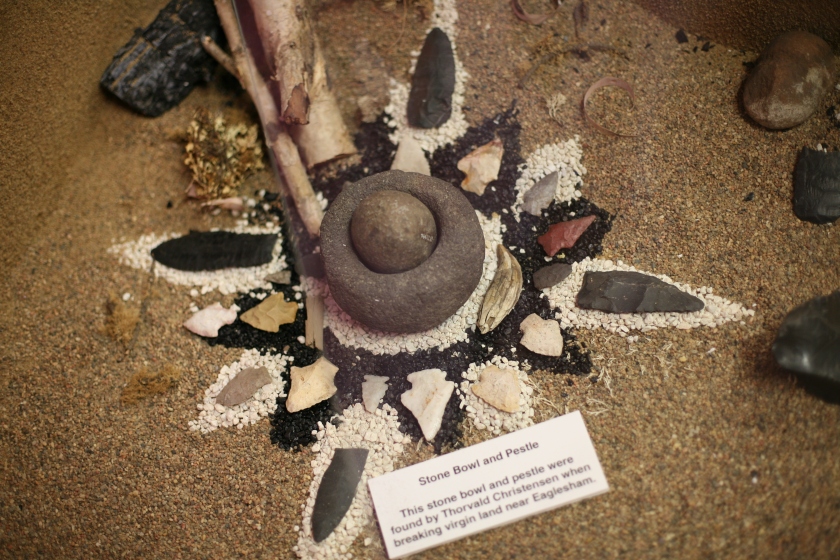
Another interpretation was suggested by Gabriel Yanicki, a PhD student at the University of Alberta. Yanicki, specializing in prehistoric gambling and games, suggests that the artifact may be a Chunkey Stone, typically associated with the Mississippi cultures in the eastern United States. The game of Chunkey involves the rolling of a stone disk while people attempt to hit the stone with spears or sticks. He went on discuss the aspects of the artifact that suggest it may be a Chunkey Stone, “at about 5 ½ inches you’re dead on for size (2-6” most common), and hard granitic or basaltic rocks aren’t unknown.” In terms of style, Yanicki states “the side where the concavity extends almost to the edge is typical of the Cahokia type, while the smaller raised concavity appears in the Salt River and Jersey Bluff types.” However, unlike typical Chunkey Stones this artifact is asymmetrical.
The artifact may also be some sort of ritual or offering platform that may have served a one time purpose. The owner of the artifact is currently talking to Augustana University in an effort to donate the artifact. The “plate” can then be tested for residue analysis to determine if there is evidence of burning or food processing. Megan Caldwell, of Augustana University is also interested in determining the origin of the rock as it appears to be similar to rocks from British Columbia.